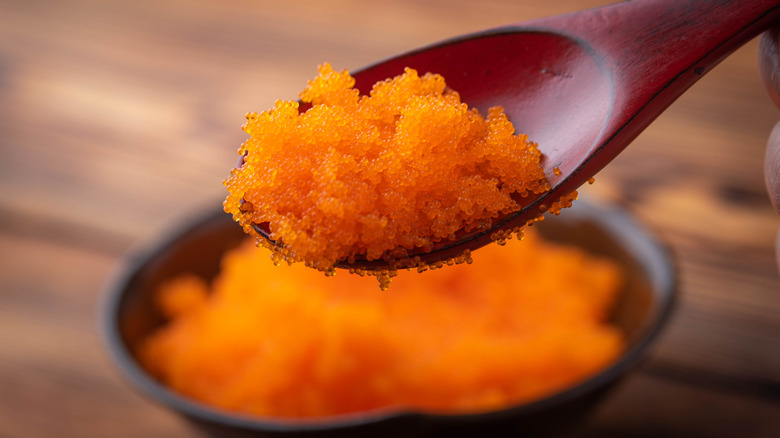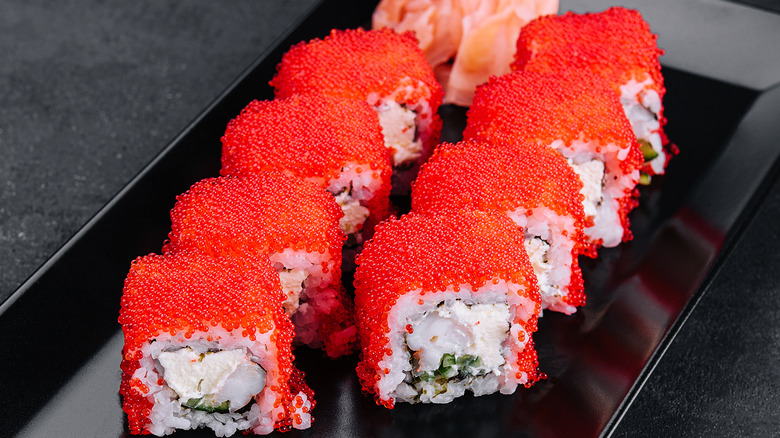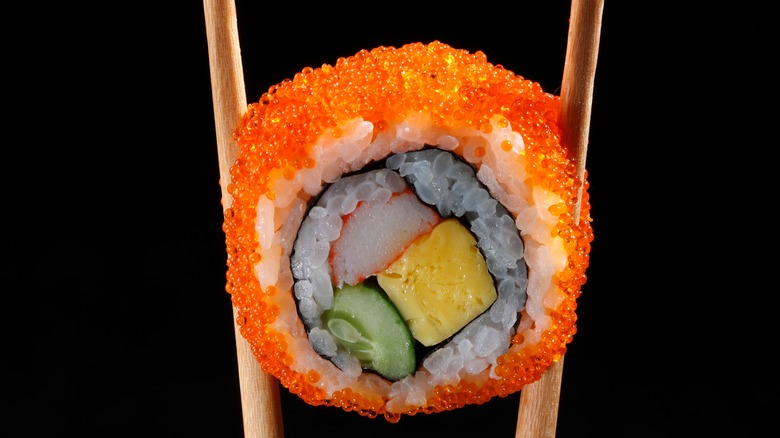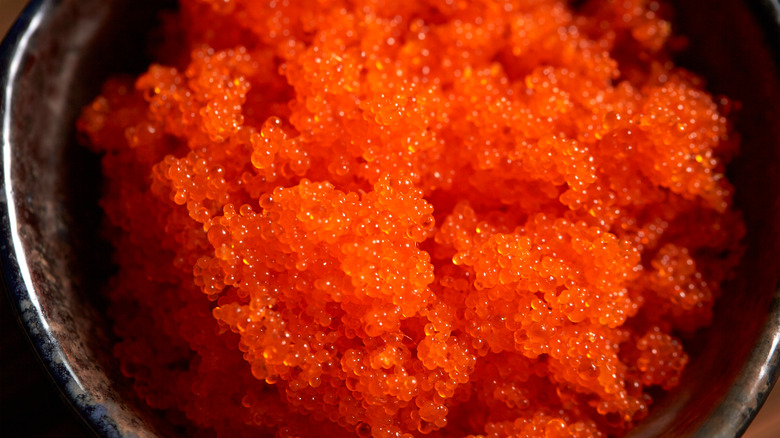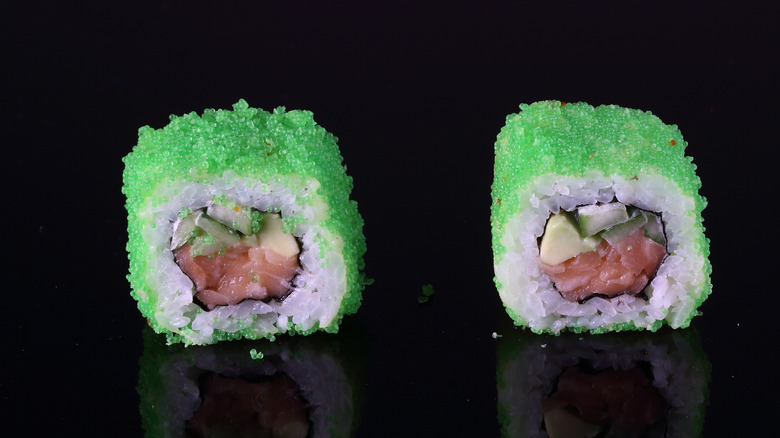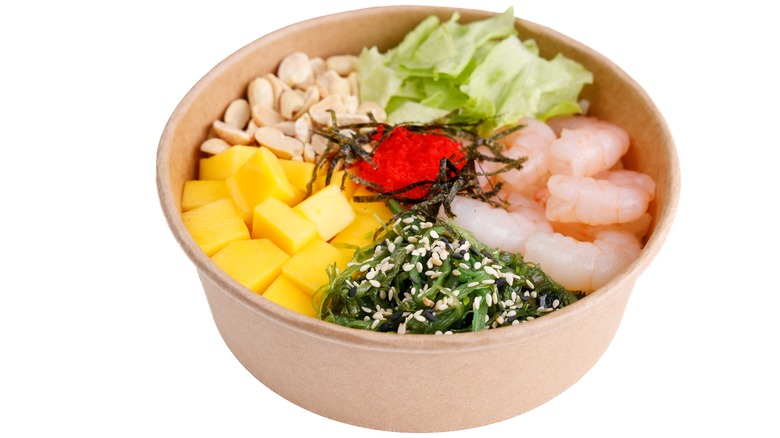What Is Masago And How Is It Prepared?
Due to its rarity and taste, Beluga may receive the most attention of all caviar — a ban on imports has made it almost impossible to find in the U.S. — but it's only one of many types of roe that are consumed. From tuna-derived Bottarga in Italy, salmon red caviar popular in Russia to spicy cod roe called mentaiko in Japan, there are many regional variations of fish eggs. One of the most affordable types is masago, a Japanese specialty that's eggs from capelin, a type of smelt fish.
Orange and small in size, masago is often confused with tobiko. In fact, masago is such a common substitution they're often dyed bright colors to mimic the flying fish roe. However, masago has a distinct taste and texture that sets it apart as a unique type of fish egg. And while most known as a decoration for sushi, this food is surprisingly versatile. Let's dive into what these tasty vivid clusters are all about.
What is masago?
Masago is a type of fish egg that's collected from capelin, a small smelt-like fish that lives in Northern waters across the Atlantic, Pacific, and Arctic Oceans. A favored prey for many aquatic animals, its flesh is not often eaten by humans. Instead, it's farmed or wild-caught primarily for its roe, although a small portion is also processed into fish oil. And due to the fact it's lower on the dietary chain, it has very low levels of mercury.
Masago has a savory oceanic flavor, with notes of saltiness and sweetness. It's milder than other kinds of roe and possesses a grainy, slightly crunchy flavor that's less explosive than the salmon roe. When harvested from fish, masago has a pale hue — its vivid color is created through dyes. Bright orange is the most popular colorant, but it's also turned green, red, or black; colors don't signify differences in masago varieties. Such coloring is carried out since masago is typically used for ornamental purposes — but that's only a dip into its culinary uses.
How masago is used in cooking
Masago is most strongly associated with sushi. There's even a specific kind of roll called masago nigiri, dedicated to the combination of nori, sushi rice, and fish egg. In addition, it's often used as a topping atop other sushi rolls, or accompanying sashimi platters.
These fish eggs are also used in a variety of sauces. The most common is in a Japanese-fusion pasta which combines the fish eggs with dashi, mayonnaise, and milk for a dressing over fettuccine pasta. Another similar version is also mayo-based but integrates some lime and sriracha to make a tasty dipping for sushi and seafood: a masago-based spicy mayo.
Masago also makes for a colorful and tasty addition to rice and noodle bowls. Even in renditions with a flavor palette not Japanese, like a Poke bowl (a Hawaiian favorite), it meshes with other ingredients. Plus, only a spoonful adds a range of health benefits.
Masago compared to other fish eggs
Masago is often used as a substitute for Tobiko; however, there are some distinctions between the two products. Tobiko comes from flying fish, and is, therefore, a bit more expensive. It's larger in size and has a texture more similar to other high-end caviar, with a pleasant bursting sensation — almost like a boba. Additionally, it has a more dependably appealing flavor since some masago may run a bit bitter. Tobiko naturally occurs with an aesthetic golden color, unlike masago, which is dyed.
Nutritionally, the two fish products are similar, so it's more a matter of mouthfeel and desired culinary application. Masago is one of the most accessible fish eggs — great for colorful dashes, a bit of flavor, and health benefits. However, it doesn't offer quite the same delectable, complex taste, and photogenic sheen as caviar or salmon roe. Consider it as a tasty component in its own right, rather than simply an affordable substitution.
Nutrition of masago
Especially in comparison to other fish eggs, masago is an accessible fish product with numerous health benefits. Most notably, it contains a generous amount of Omega-3, an esteemed type of fat found mainly in seafood. This substance regulates inflammation and blood flow and helps reduce the risk of heart conditions. Masago is also high in protein, with a one-ounce serving containing the same quantity as an egg. Protein-dense foods are shown to better regulate cholesterol, reduce cravings, and increase muscle strength, notes WebMD.
Masago contains other beneficial compounds, too. Most notably, an ounce delivers almost half the daily requirement of vitamin B12. This compound can only be attained through diet and is involved in important functions like energy systems and the creation of red blood cells. Additionally, these fish eggs are a source of selenium, an antioxidant that aids the immune system, per Healthline. Such effects don't necessitate a large serving — all the more reason to throw a spoon atop a rice bowl.
How to purchase and store masago
Masago is increasingly available in the U.S. thanks to imported varieties harvested from Iceland. It can be found in specialty seafood and Japanese groceries, typically located near other products made for sushi. There are also many online purveyors that will ship the fish egg. If it can't be located, you can purchase tobiko instead, since the two fish egg products are so similar.
Though Masago is a raw product, it holds up well to being frozen. Most often, it's shipped in frozen form. In the freezer, it'll store for around six months. After thawing, it's suitable to use for up to five days. It's best to store it in a sterilized, tight-fitting jar.
If dealing with a fresh batch, simply use enough for the occasion and freeze the rest. Or throw it onto a dish as a colorful topping — it'll add an appealing burst of seafood flavor.
